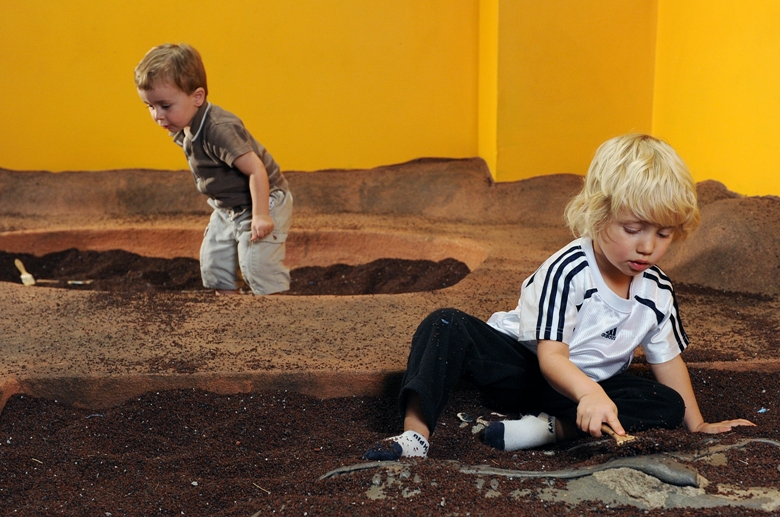Preschoolers exploring the surface of Mars at Denver science museum

DENVER, CO (Day 3) — Can you carve out shapes in the water that look like photos from Mars?
On a recent Tuesday, a group of pre schoolers were busy doing just that at the Denver Museum of Nature and Science.
In the Discovery Zone, kids were digging for “fossils” in Dinosaur Gulch, listening to a story, constructing towers on one table and a dinosaur community on another.
There are organized activities every day and when the new Discovery Zone opens next summer in the museum’s about to open new building it will be much larger and even more engaging. Locals are especially excited about the new Maya exhibit coming next month that is chock full of interactives.
Visitors to Colorado may not realize that dinosaurs have been found right around Denver and there are many places –including Dinosaur Ridge where you can go and see bones in the rock or dinosaur footprints.
Here, at the country’s fourth largest Natural History Museum, you can explore dinosaurs in a whole new way. See the cast of a giant Allsaurus that was found by a 13-year-old girl in Colorado in 1979; There’s a stegosaurs found by a teacher in Colorado.
Did you know Duckbill Dinosaurs were good parents? They laid eggs in the next, took care of babies and traveled in groups. Check out the dinosaur eggs!
There are plenty of chances to touch a fossil, consider that Colorado was once under water, feel a mastodon’s tooth or watch paleontologists and trained volunteers at work behind a big glass wall in their lab.
How do you tell the difference between a Mastadon and a Mammoth? Their teeth! Mammoth’s gargantuan teeth had far more ridges—for grinding up grass. Mastadons ate more leaves and bark.
A tip for visitors—just outside is the perfect setting for your next Christmas Card—with the Denver Skyline and the Rocky Mountains. Locals say it’s the best view in Denver!
But my favorite at this museum wasn’t the dinos or the discovery zone. It’s the completely interactive Expedition Health that teaches you about living in high altitude and staying healthy.
You choose a buddy to go along with you on Expedition Health—your “Peak Pass” that you plug into the kiosks will offer games and commentary from your buddy.
We were joined by Andy, a teen from Fort Collins who plays Hockey. We could have been guided by Naomi, who liked biking or Trish, a science teacher or Alexis who collects rubber duckies—they are all real people, we learn at the end.
We stop at one exhibit and see how our heart pumps. Exercise, of course, will keep our hearts healthier. We go along on an interactive expedition to the top of Mt. Evans, one of Colorado’s famous “fourteeners” –peaks over 14,000 peaks high—and just west of Denver.
When you are hiking:
–take only pictures; leave natural items for the net person
–drink only treated water
–bring clothes for all weather
–stay off high ridges during lightening.
Take a muscle Challenge or stop at Biology Base Camp where you can extract real DNA molecules, discover what kinds of soap kill bacteria or test the sugar content in cereals.
At another computer station, you can play a “Traumas on the Trail” game or stop and see how your face might look when you are 70. Smoking, over exposure to the sun and over-eating, we learn, will do nothing to improve your appearance as you age.
Teens, we learn, have the best sense of smell.
I flop at the game where I’m trying to nutritious food for my hiking buddy to make it to the mountain peak; I didn’t give him enough grains!
Here’s a tip: Bright green veggies have the most vitamins and minerals.
Did you know there are 206 bones in your skeleton? You can see your skeleton in front of one screen as you move.
Check out how a granola bar looks as it goes through your digestive system. Gross!



